Literature Review and Equality in the Workplace: Study Skills Report
VerifiedAdded on 2020/10/05
|9
|2702
|333
Report
AI Summary
This report delves into the significance of literature reviews, explaining their purpose and objectives in examining a topic authentically. It emphasizes the importance of understanding the current knowledge and methodologies in a particular area of study. The report also explores the concept of equality in the workplace, focusing on gender differences and the need for fair treatment. It highlights the importance of treating all employees equally and the need to address and prevent discrimination. The report discusses the right to equality as a fundamental right and its relevance in an organizational context. It also examines gender equality, the gaps in organizational levels, and the impact of various factors such as education, skills, and stereotypes. The report further explores different types of equality, the impact of competition, and the importance of workforce diversity. It concludes by emphasizing the importance of promoting equality and adhering to policies, regulations, and laws to ensure a balanced and productive workplace.
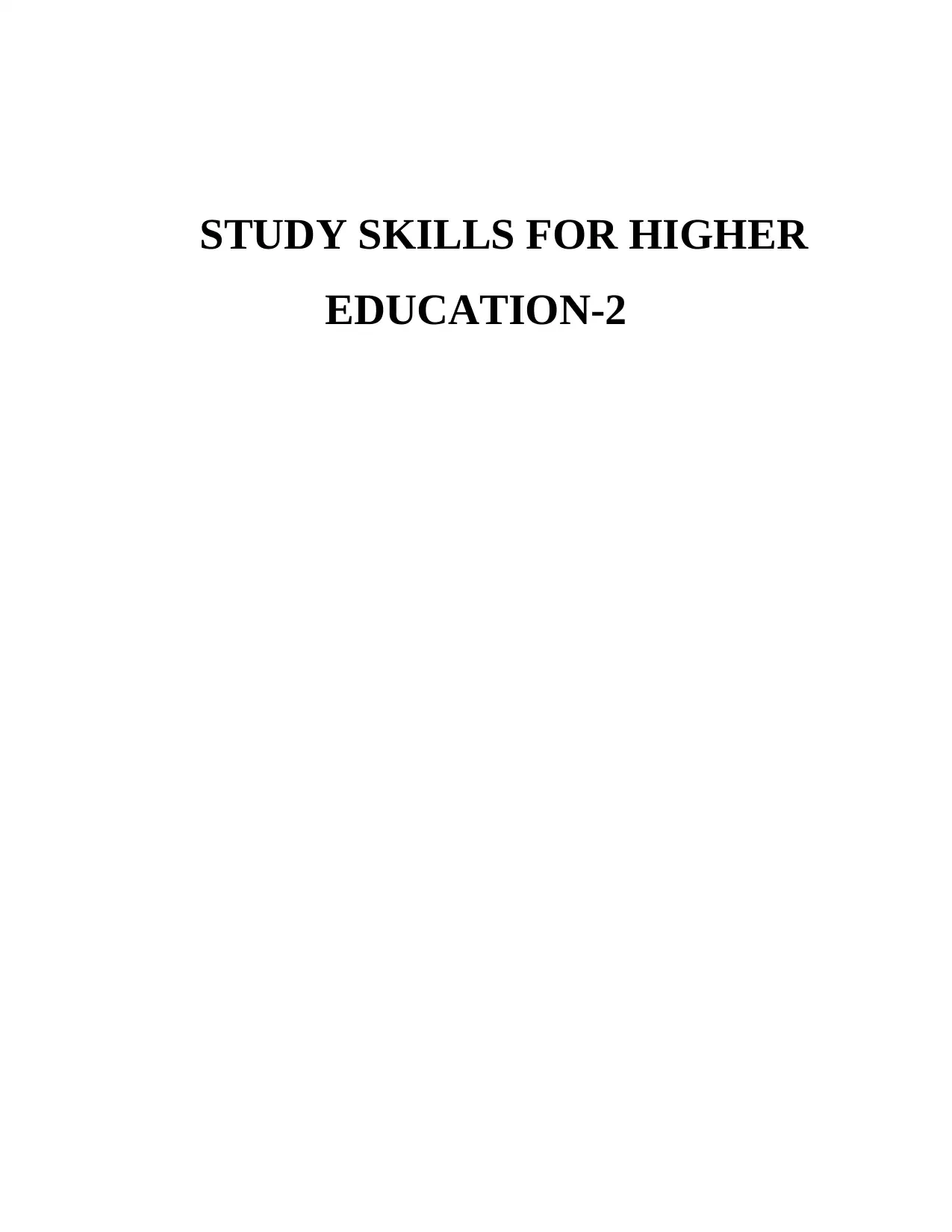
STUDY SKILLS FOR HIGHER
EDUCATION-2
EDUCATION-2
Paraphrase This Document
Need a fresh take? Get an instant paraphrase of this document with our AI Paraphraser
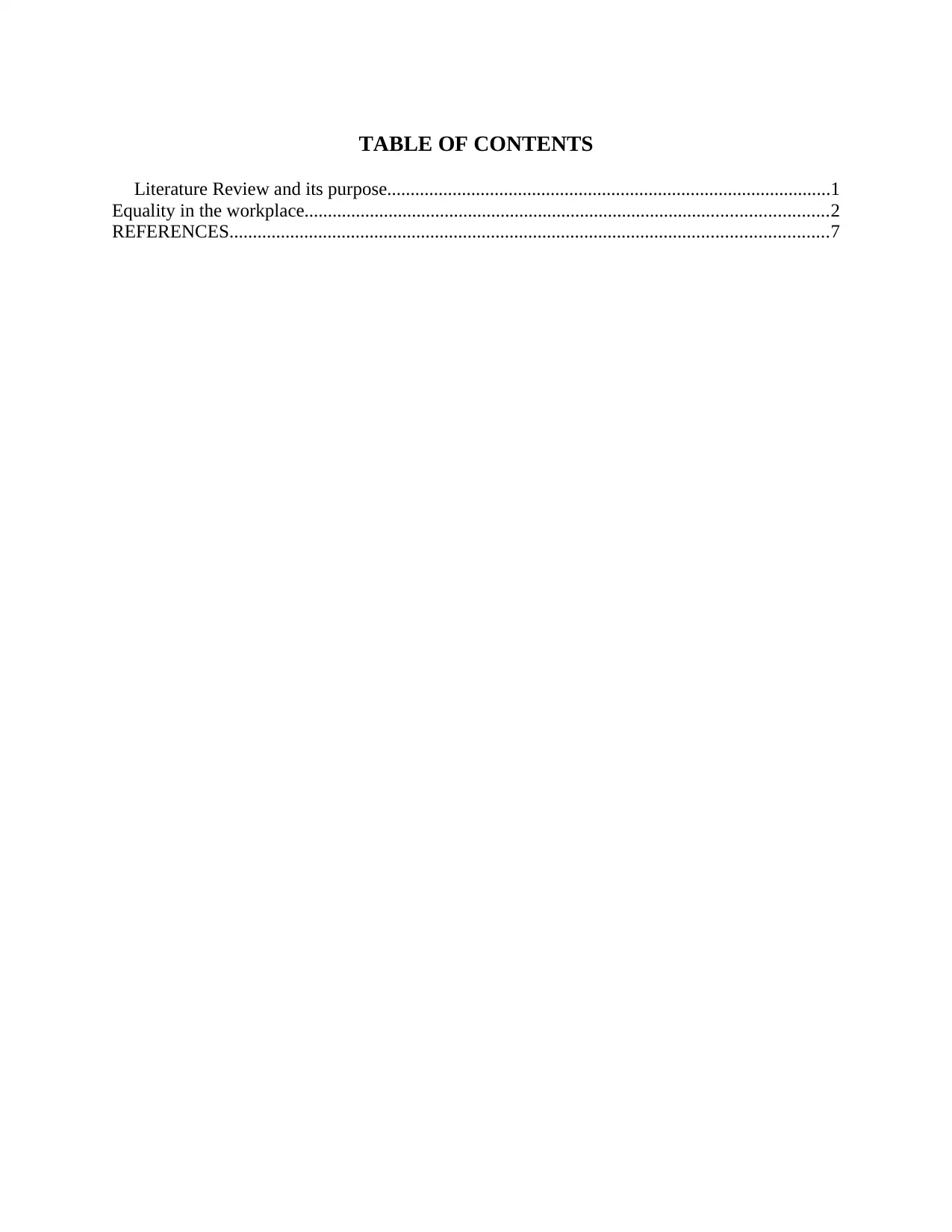
TABLE OF CONTENTS
Literature Review and its purpose...............................................................................................1
Equality in the workplace................................................................................................................2
REFERENCES................................................................................................................................7
Literature Review and its purpose...............................................................................................1
Equality in the workplace................................................................................................................2
REFERENCES................................................................................................................................7
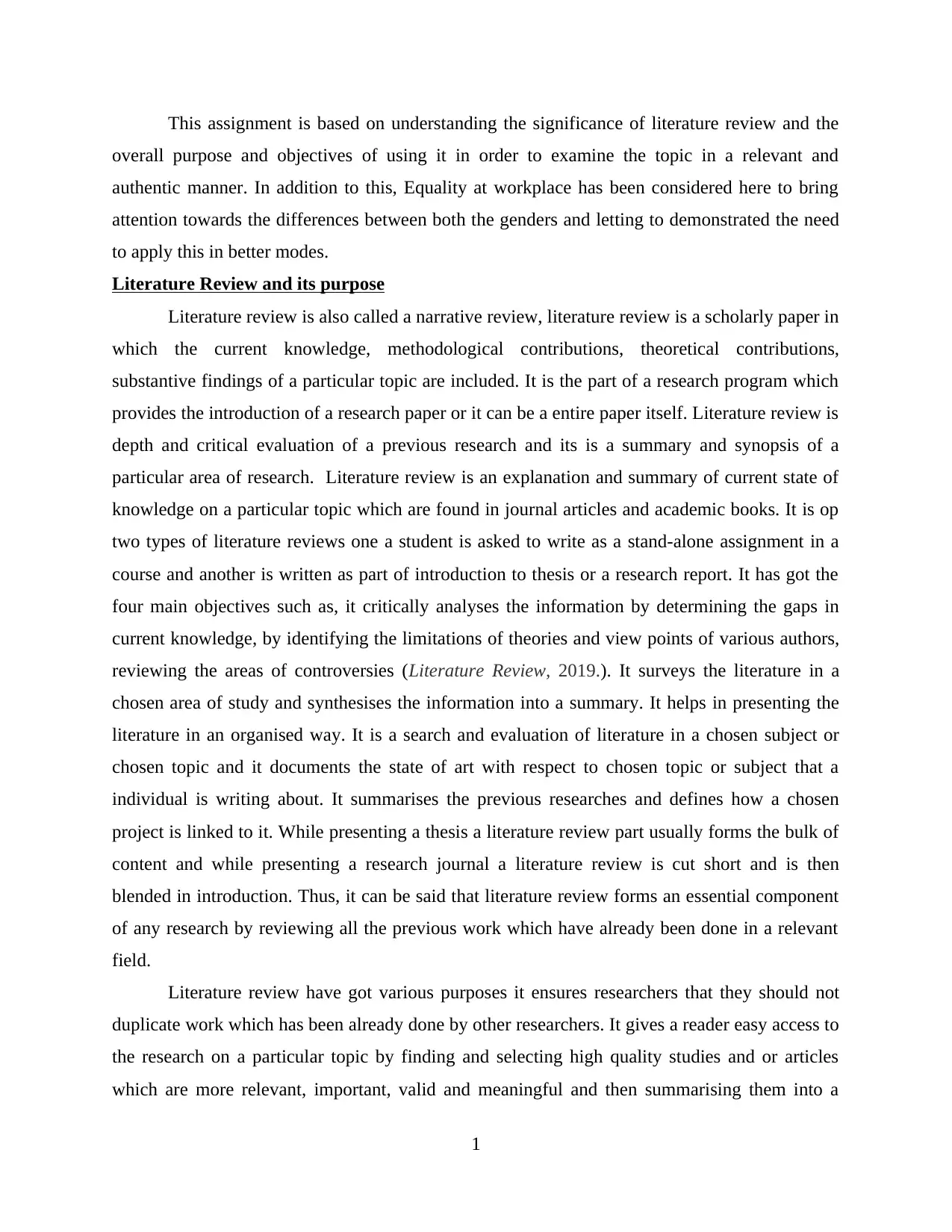
This assignment is based on understanding the significance of literature review and the
overall purpose and objectives of using it in order to examine the topic in a relevant and
authentic manner. In addition to this, Equality at workplace has been considered here to bring
attention towards the differences between both the genders and letting to demonstrated the need
to apply this in better modes.
Literature Review and its purpose
Literature review is also called a narrative review, literature review is a scholarly paper in
which the current knowledge, methodological contributions, theoretical contributions,
substantive findings of a particular topic are included. It is the part of a research program which
provides the introduction of a research paper or it can be a entire paper itself. Literature review is
depth and critical evaluation of a previous research and its is a summary and synopsis of a
particular area of research. Literature review is an explanation and summary of current state of
knowledge on a particular topic which are found in journal articles and academic books. It is op
two types of literature reviews one a student is asked to write as a stand-alone assignment in a
course and another is written as part of introduction to thesis or a research report. It has got the
four main objectives such as, it critically analyses the information by determining the gaps in
current knowledge, by identifying the limitations of theories and view points of various authors,
reviewing the areas of controversies (Literature Review, 2019.). It surveys the literature in a
chosen area of study and synthesises the information into a summary. It helps in presenting the
literature in an organised way. It is a search and evaluation of literature in a chosen subject or
chosen topic and it documents the state of art with respect to chosen topic or subject that a
individual is writing about. It summarises the previous researches and defines how a chosen
project is linked to it. While presenting a thesis a literature review part usually forms the bulk of
content and while presenting a research journal a literature review is cut short and is then
blended in introduction. Thus, it can be said that literature review forms an essential component
of any research by reviewing all the previous work which have already been done in a relevant
field.
Literature review have got various purposes it ensures researchers that they should not
duplicate work which has been already done by other researchers. It gives a reader easy access to
the research on a particular topic by finding and selecting high quality studies and or articles
which are more relevant, important, valid and meaningful and then summarising them into a
1
overall purpose and objectives of using it in order to examine the topic in a relevant and
authentic manner. In addition to this, Equality at workplace has been considered here to bring
attention towards the differences between both the genders and letting to demonstrated the need
to apply this in better modes.
Literature Review and its purpose
Literature review is also called a narrative review, literature review is a scholarly paper in
which the current knowledge, methodological contributions, theoretical contributions,
substantive findings of a particular topic are included. It is the part of a research program which
provides the introduction of a research paper or it can be a entire paper itself. Literature review is
depth and critical evaluation of a previous research and its is a summary and synopsis of a
particular area of research. Literature review is an explanation and summary of current state of
knowledge on a particular topic which are found in journal articles and academic books. It is op
two types of literature reviews one a student is asked to write as a stand-alone assignment in a
course and another is written as part of introduction to thesis or a research report. It has got the
four main objectives such as, it critically analyses the information by determining the gaps in
current knowledge, by identifying the limitations of theories and view points of various authors,
reviewing the areas of controversies (Literature Review, 2019.). It surveys the literature in a
chosen area of study and synthesises the information into a summary. It helps in presenting the
literature in an organised way. It is a search and evaluation of literature in a chosen subject or
chosen topic and it documents the state of art with respect to chosen topic or subject that a
individual is writing about. It summarises the previous researches and defines how a chosen
project is linked to it. While presenting a thesis a literature review part usually forms the bulk of
content and while presenting a research journal a literature review is cut short and is then
blended in introduction. Thus, it can be said that literature review forms an essential component
of any research by reviewing all the previous work which have already been done in a relevant
field.
Literature review have got various purposes it ensures researchers that they should not
duplicate work which has been already done by other researchers. It gives a reader easy access to
the research on a particular topic by finding and selecting high quality studies and or articles
which are more relevant, important, valid and meaningful and then summarising them into a
1
⊘ This is a preview!⊘
Do you want full access?
Subscribe today to unlock all pages.

Trusted by 1+ million students worldwide
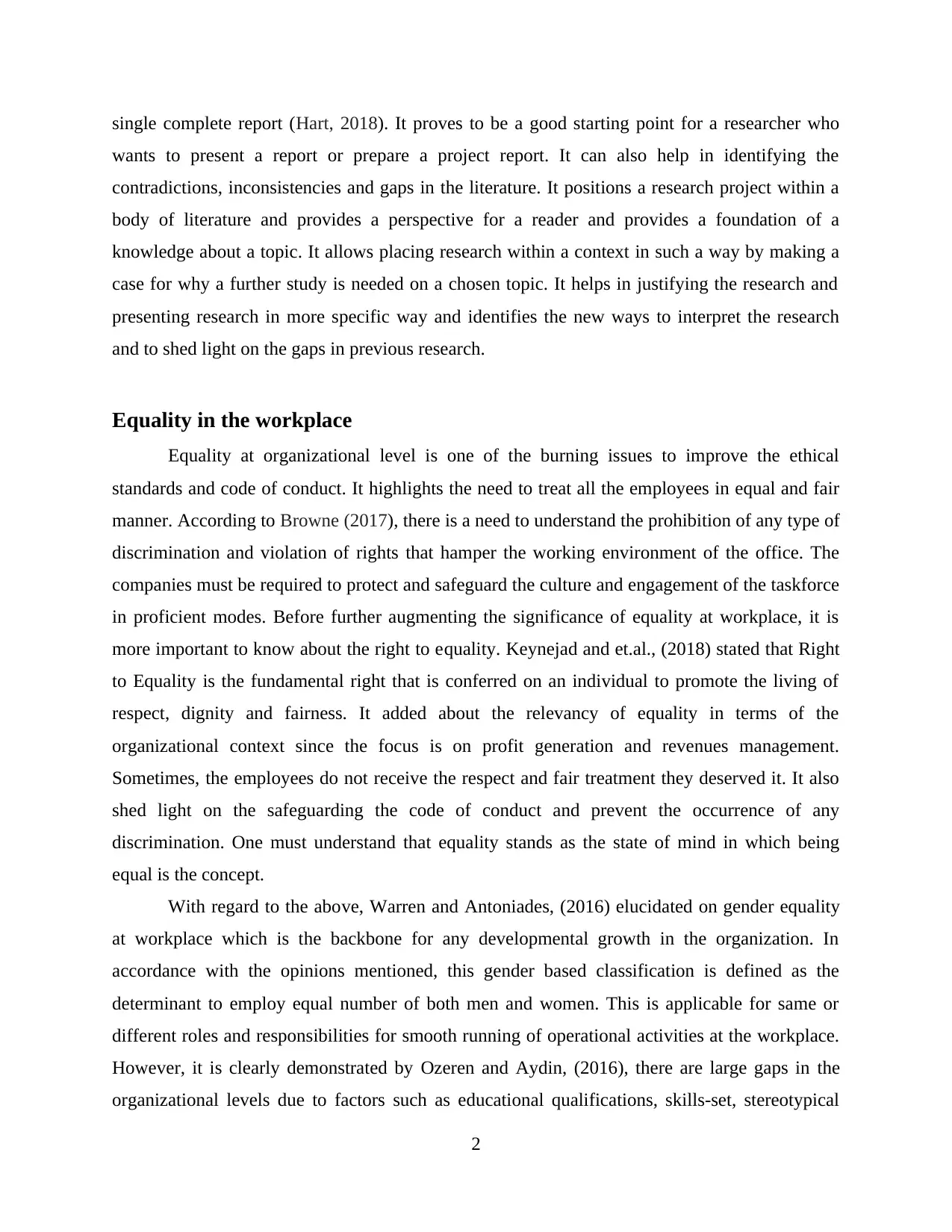
single complete report (Hart, 2018). It proves to be a good starting point for a researcher who
wants to present a report or prepare a project report. It can also help in identifying the
contradictions, inconsistencies and gaps in the literature. It positions a research project within a
body of literature and provides a perspective for a reader and provides a foundation of a
knowledge about a topic. It allows placing research within a context in such a way by making a
case for why a further study is needed on a chosen topic. It helps in justifying the research and
presenting research in more specific way and identifies the new ways to interpret the research
and to shed light on the gaps in previous research.
Equality in the workplace
Equality at organizational level is one of the burning issues to improve the ethical
standards and code of conduct. It highlights the need to treat all the employees in equal and fair
manner. According to Browne (2017), there is a need to understand the prohibition of any type of
discrimination and violation of rights that hamper the working environment of the office. The
companies must be required to protect and safeguard the culture and engagement of the taskforce
in proficient modes. Before further augmenting the significance of equality at workplace, it is
more important to know about the right to equality. Keynejad and et.al., (2018) stated that Right
to Equality is the fundamental right that is conferred on an individual to promote the living of
respect, dignity and fairness. It added about the relevancy of equality in terms of the
organizational context since the focus is on profit generation and revenues management.
Sometimes, the employees do not receive the respect and fair treatment they deserved it. It also
shed light on the safeguarding the code of conduct and prevent the occurrence of any
discrimination. One must understand that equality stands as the state of mind in which being
equal is the concept.
With regard to the above, Warren and Antoniades, (2016) elucidated on gender equality
at workplace which is the backbone for any developmental growth in the organization. In
accordance with the opinions mentioned, this gender based classification is defined as the
determinant to employ equal number of both men and women. This is applicable for same or
different roles and responsibilities for smooth running of operational activities at the workplace.
However, it is clearly demonstrated by Ozeren and Aydin, (2016), there are large gaps in the
organizational levels due to factors such as educational qualifications, skills-set, stereotypical
2
wants to present a report or prepare a project report. It can also help in identifying the
contradictions, inconsistencies and gaps in the literature. It positions a research project within a
body of literature and provides a perspective for a reader and provides a foundation of a
knowledge about a topic. It allows placing research within a context in such a way by making a
case for why a further study is needed on a chosen topic. It helps in justifying the research and
presenting research in more specific way and identifies the new ways to interpret the research
and to shed light on the gaps in previous research.
Equality in the workplace
Equality at organizational level is one of the burning issues to improve the ethical
standards and code of conduct. It highlights the need to treat all the employees in equal and fair
manner. According to Browne (2017), there is a need to understand the prohibition of any type of
discrimination and violation of rights that hamper the working environment of the office. The
companies must be required to protect and safeguard the culture and engagement of the taskforce
in proficient modes. Before further augmenting the significance of equality at workplace, it is
more important to know about the right to equality. Keynejad and et.al., (2018) stated that Right
to Equality is the fundamental right that is conferred on an individual to promote the living of
respect, dignity and fairness. It added about the relevancy of equality in terms of the
organizational context since the focus is on profit generation and revenues management.
Sometimes, the employees do not receive the respect and fair treatment they deserved it. It also
shed light on the safeguarding the code of conduct and prevent the occurrence of any
discrimination. One must understand that equality stands as the state of mind in which being
equal is the concept.
With regard to the above, Warren and Antoniades, (2016) elucidated on gender equality
at workplace which is the backbone for any developmental growth in the organization. In
accordance with the opinions mentioned, this gender based classification is defined as the
determinant to employ equal number of both men and women. This is applicable for same or
different roles and responsibilities for smooth running of operational activities at the workplace.
However, it is clearly demonstrated by Ozeren and Aydin, (2016), there are large gaps in the
organizational levels due to factors such as educational qualifications, skills-set, stereotypical
2
Paraphrase This Document
Need a fresh take? Get an instant paraphrase of this document with our AI Paraphraser
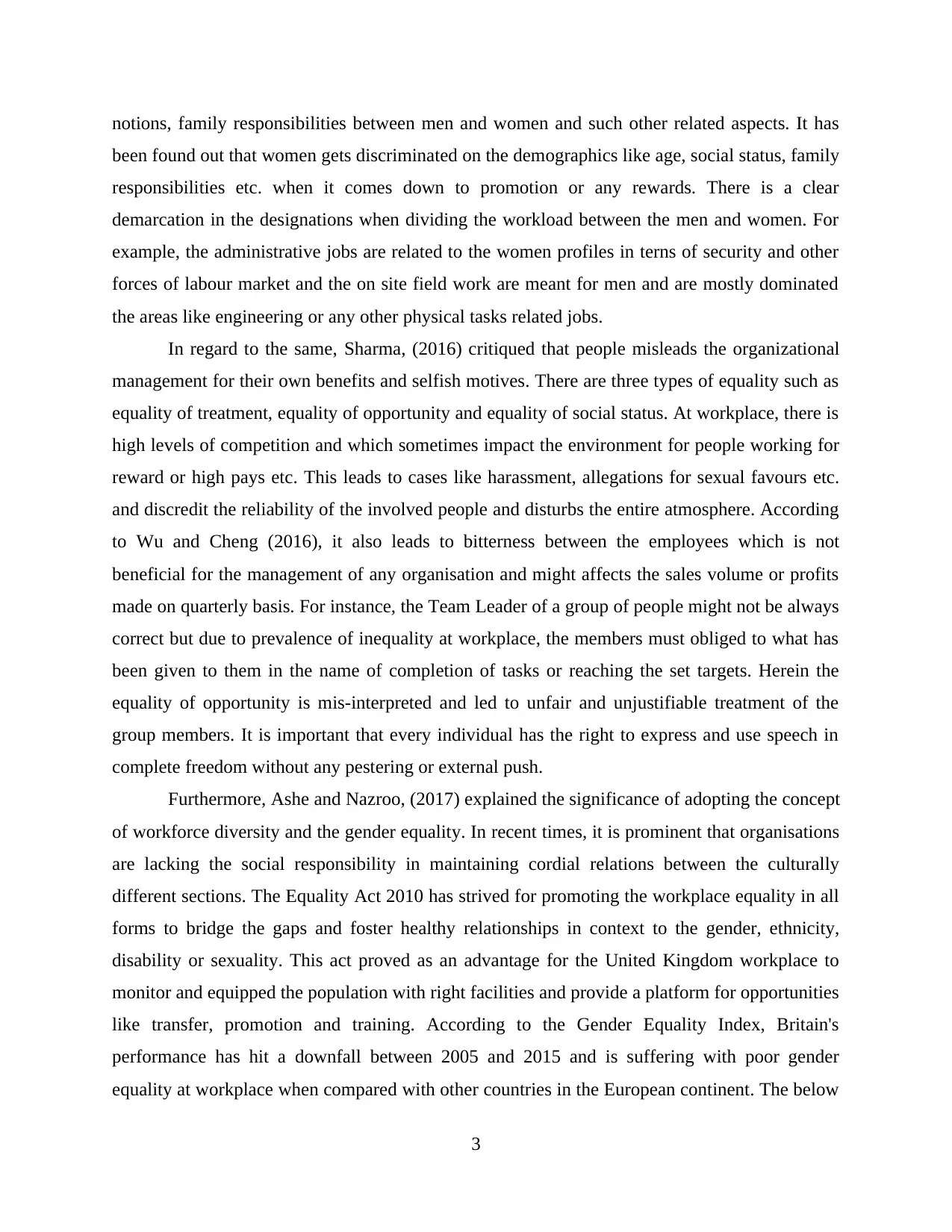
notions, family responsibilities between men and women and such other related aspects. It has
been found out that women gets discriminated on the demographics like age, social status, family
responsibilities etc. when it comes down to promotion or any rewards. There is a clear
demarcation in the designations when dividing the workload between the men and women. For
example, the administrative jobs are related to the women profiles in terns of security and other
forces of labour market and the on site field work are meant for men and are mostly dominated
the areas like engineering or any other physical tasks related jobs.
In regard to the same, Sharma, (2016) critiqued that people misleads the organizational
management for their own benefits and selfish motives. There are three types of equality such as
equality of treatment, equality of opportunity and equality of social status. At workplace, there is
high levels of competition and which sometimes impact the environment for people working for
reward or high pays etc. This leads to cases like harassment, allegations for sexual favours etc.
and discredit the reliability of the involved people and disturbs the entire atmosphere. According
to Wu and Cheng (2016), it also leads to bitterness between the employees which is not
beneficial for the management of any organisation and might affects the sales volume or profits
made on quarterly basis. For instance, the Team Leader of a group of people might not be always
correct but due to prevalence of inequality at workplace, the members must obliged to what has
been given to them in the name of completion of tasks or reaching the set targets. Herein the
equality of opportunity is mis-interpreted and led to unfair and unjustifiable treatment of the
group members. It is important that every individual has the right to express and use speech in
complete freedom without any pestering or external push.
Furthermore, Ashe and Nazroo, (2017) explained the significance of adopting the concept
of workforce diversity and the gender equality. In recent times, it is prominent that organisations
are lacking the social responsibility in maintaining cordial relations between the culturally
different sections. The Equality Act 2010 has strived for promoting the workplace equality in all
forms to bridge the gaps and foster healthy relationships in context to the gender, ethnicity,
disability or sexuality. This act proved as an advantage for the United Kingdom workplace to
monitor and equipped the population with right facilities and provide a platform for opportunities
like transfer, promotion and training. According to the Gender Equality Index, Britain's
performance has hit a downfall between 2005 and 2015 and is suffering with poor gender
equality at workplace when compared with other countries in the European continent. The below
3
been found out that women gets discriminated on the demographics like age, social status, family
responsibilities etc. when it comes down to promotion or any rewards. There is a clear
demarcation in the designations when dividing the workload between the men and women. For
example, the administrative jobs are related to the women profiles in terns of security and other
forces of labour market and the on site field work are meant for men and are mostly dominated
the areas like engineering or any other physical tasks related jobs.
In regard to the same, Sharma, (2016) critiqued that people misleads the organizational
management for their own benefits and selfish motives. There are three types of equality such as
equality of treatment, equality of opportunity and equality of social status. At workplace, there is
high levels of competition and which sometimes impact the environment for people working for
reward or high pays etc. This leads to cases like harassment, allegations for sexual favours etc.
and discredit the reliability of the involved people and disturbs the entire atmosphere. According
to Wu and Cheng (2016), it also leads to bitterness between the employees which is not
beneficial for the management of any organisation and might affects the sales volume or profits
made on quarterly basis. For instance, the Team Leader of a group of people might not be always
correct but due to prevalence of inequality at workplace, the members must obliged to what has
been given to them in the name of completion of tasks or reaching the set targets. Herein the
equality of opportunity is mis-interpreted and led to unfair and unjustifiable treatment of the
group members. It is important that every individual has the right to express and use speech in
complete freedom without any pestering or external push.
Furthermore, Ashe and Nazroo, (2017) explained the significance of adopting the concept
of workforce diversity and the gender equality. In recent times, it is prominent that organisations
are lacking the social responsibility in maintaining cordial relations between the culturally
different sections. The Equality Act 2010 has strived for promoting the workplace equality in all
forms to bridge the gaps and foster healthy relationships in context to the gender, ethnicity,
disability or sexuality. This act proved as an advantage for the United Kingdom workplace to
monitor and equipped the population with right facilities and provide a platform for opportunities
like transfer, promotion and training. According to the Gender Equality Index, Britain's
performance has hit a downfall between 2005 and 2015 and is suffering with poor gender
equality at workplace when compared with other countries in the European continent. The below
3
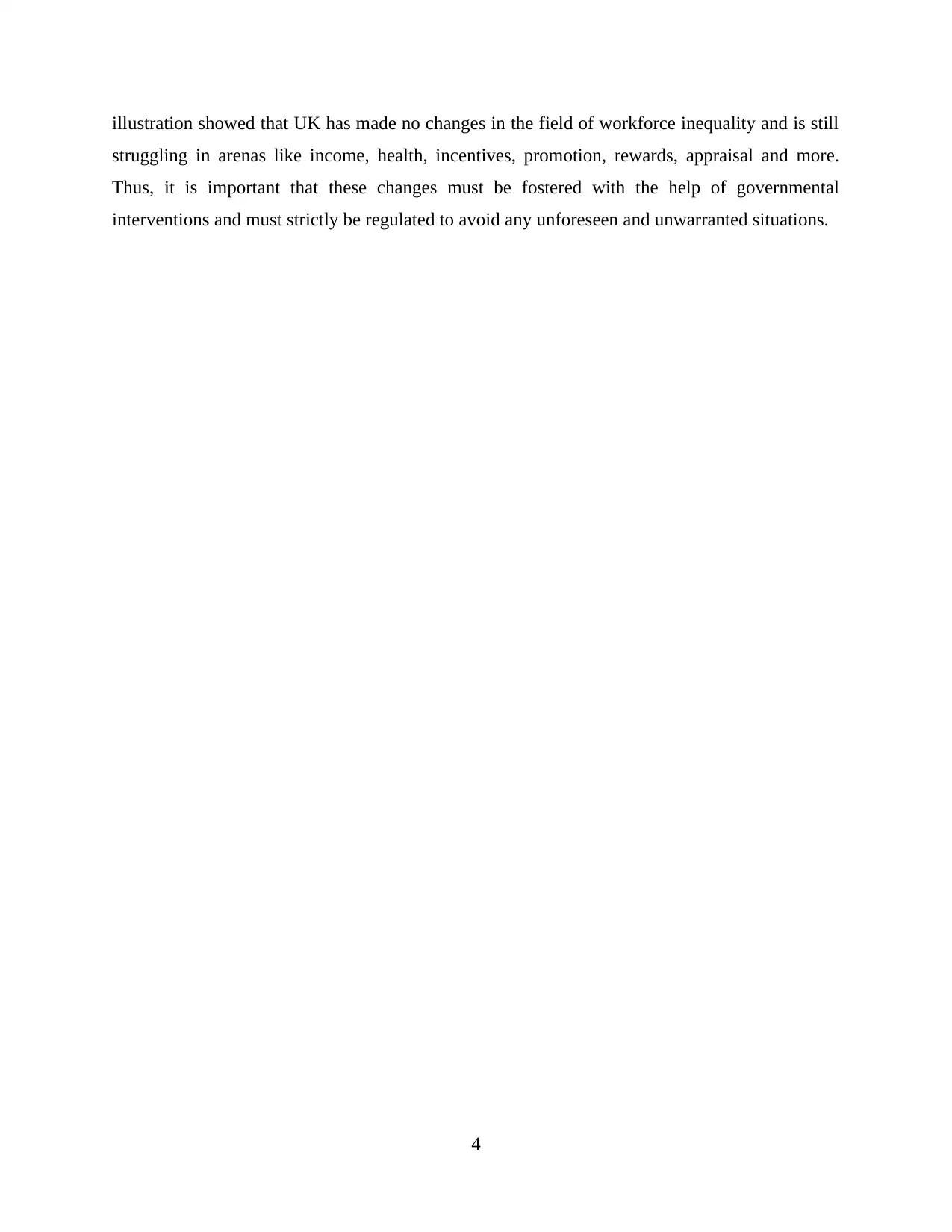
illustration showed that UK has made no changes in the field of workforce inequality and is still
struggling in arenas like income, health, incentives, promotion, rewards, appraisal and more.
Thus, it is important that these changes must be fostered with the help of governmental
interventions and must strictly be regulated to avoid any unforeseen and unwarranted situations.
4
struggling in arenas like income, health, incentives, promotion, rewards, appraisal and more.
Thus, it is important that these changes must be fostered with the help of governmental
interventions and must strictly be regulated to avoid any unforeseen and unwarranted situations.
4
⊘ This is a preview!⊘
Do you want full access?
Subscribe today to unlock all pages.

Trusted by 1+ million students worldwide
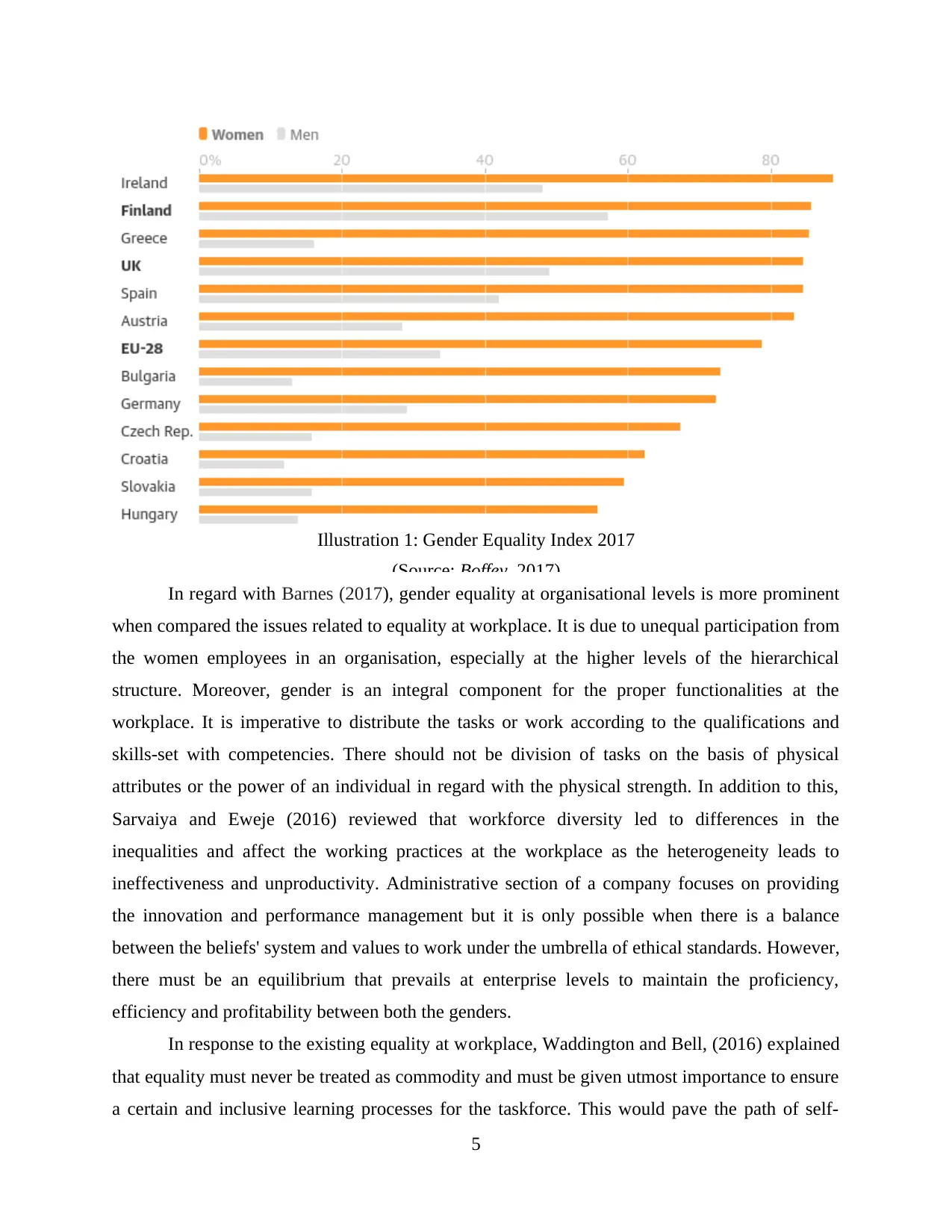
In regard with Barnes (2017), gender equality at organisational levels is more prominent
when compared the issues related to equality at workplace. It is due to unequal participation from
the women employees in an organisation, especially at the higher levels of the hierarchical
structure. Moreover, gender is an integral component for the proper functionalities at the
workplace. It is imperative to distribute the tasks or work according to the qualifications and
skills-set with competencies. There should not be division of tasks on the basis of physical
attributes or the power of an individual in regard with the physical strength. In addition to this,
Sarvaiya and Eweje (2016) reviewed that workforce diversity led to differences in the
inequalities and affect the working practices at the workplace as the heterogeneity leads to
ineffectiveness and unproductivity. Administrative section of a company focuses on providing
the innovation and performance management but it is only possible when there is a balance
between the beliefs' system and values to work under the umbrella of ethical standards. However,
there must be an equilibrium that prevails at enterprise levels to maintain the proficiency,
efficiency and profitability between both the genders.
In response to the existing equality at workplace, Waddington and Bell, (2016) explained
that equality must never be treated as commodity and must be given utmost importance to ensure
a certain and inclusive learning processes for the taskforce. This would pave the path of self-
5
Illustration 1: Gender Equality Index 2017
(Source: Boffey, 2017)
when compared the issues related to equality at workplace. It is due to unequal participation from
the women employees in an organisation, especially at the higher levels of the hierarchical
structure. Moreover, gender is an integral component for the proper functionalities at the
workplace. It is imperative to distribute the tasks or work according to the qualifications and
skills-set with competencies. There should not be division of tasks on the basis of physical
attributes or the power of an individual in regard with the physical strength. In addition to this,
Sarvaiya and Eweje (2016) reviewed that workforce diversity led to differences in the
inequalities and affect the working practices at the workplace as the heterogeneity leads to
ineffectiveness and unproductivity. Administrative section of a company focuses on providing
the innovation and performance management but it is only possible when there is a balance
between the beliefs' system and values to work under the umbrella of ethical standards. However,
there must be an equilibrium that prevails at enterprise levels to maintain the proficiency,
efficiency and profitability between both the genders.
In response to the existing equality at workplace, Waddington and Bell, (2016) explained
that equality must never be treated as commodity and must be given utmost importance to ensure
a certain and inclusive learning processes for the taskforce. This would pave the path of self-
5
Illustration 1: Gender Equality Index 2017
(Source: Boffey, 2017)
Paraphrase This Document
Need a fresh take? Get an instant paraphrase of this document with our AI Paraphraser
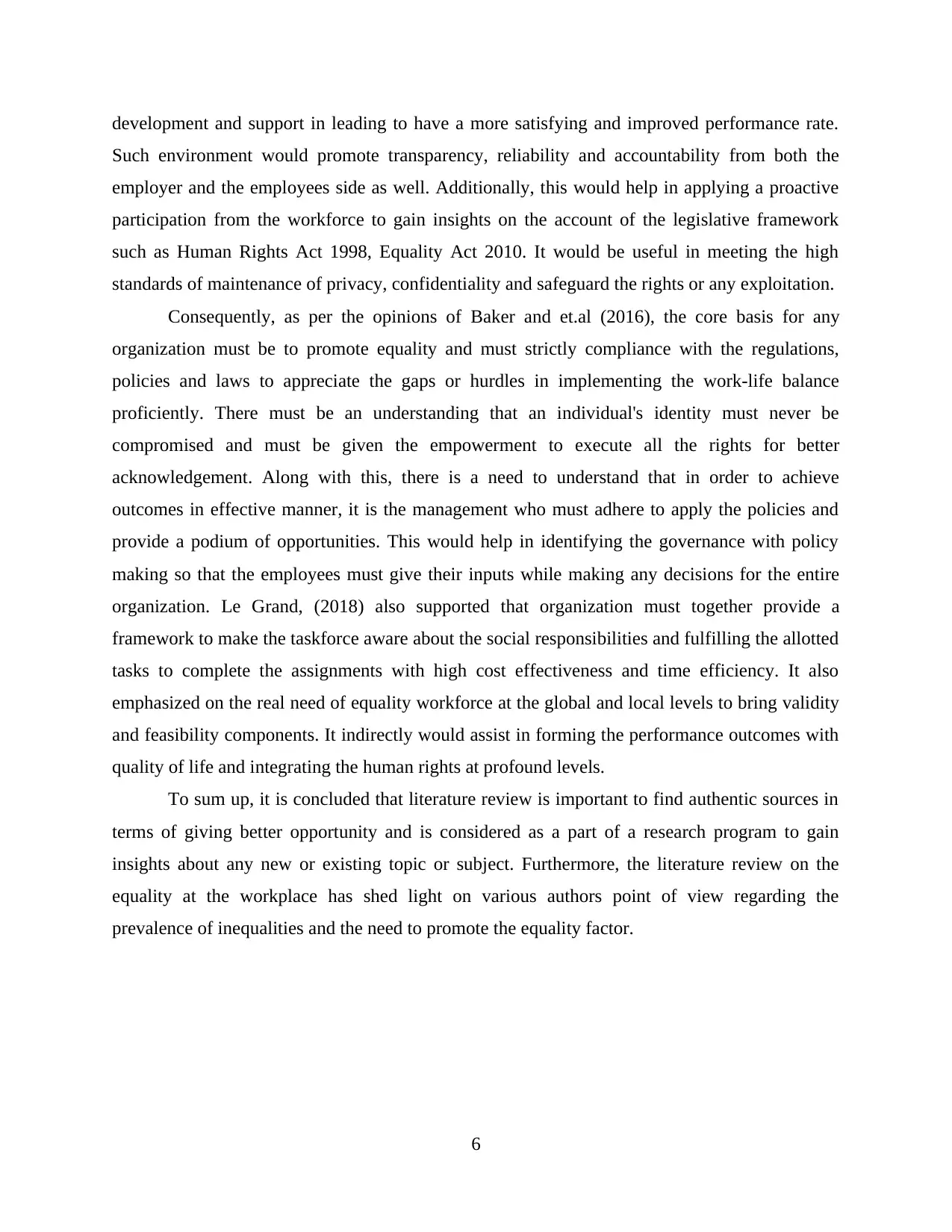
development and support in leading to have a more satisfying and improved performance rate.
Such environment would promote transparency, reliability and accountability from both the
employer and the employees side as well. Additionally, this would help in applying a proactive
participation from the workforce to gain insights on the account of the legislative framework
such as Human Rights Act 1998, Equality Act 2010. It would be useful in meeting the high
standards of maintenance of privacy, confidentiality and safeguard the rights or any exploitation.
Consequently, as per the opinions of Baker and et.al (2016), the core basis for any
organization must be to promote equality and must strictly compliance with the regulations,
policies and laws to appreciate the gaps or hurdles in implementing the work-life balance
proficiently. There must be an understanding that an individual's identity must never be
compromised and must be given the empowerment to execute all the rights for better
acknowledgement. Along with this, there is a need to understand that in order to achieve
outcomes in effective manner, it is the management who must adhere to apply the policies and
provide a podium of opportunities. This would help in identifying the governance with policy
making so that the employees must give their inputs while making any decisions for the entire
organization. Le Grand, (2018) also supported that organization must together provide a
framework to make the taskforce aware about the social responsibilities and fulfilling the allotted
tasks to complete the assignments with high cost effectiveness and time efficiency. It also
emphasized on the real need of equality workforce at the global and local levels to bring validity
and feasibility components. It indirectly would assist in forming the performance outcomes with
quality of life and integrating the human rights at profound levels.
To sum up, it is concluded that literature review is important to find authentic sources in
terms of giving better opportunity and is considered as a part of a research program to gain
insights about any new or existing topic or subject. Furthermore, the literature review on the
equality at the workplace has shed light on various authors point of view regarding the
prevalence of inequalities and the need to promote the equality factor.
6
Such environment would promote transparency, reliability and accountability from both the
employer and the employees side as well. Additionally, this would help in applying a proactive
participation from the workforce to gain insights on the account of the legislative framework
such as Human Rights Act 1998, Equality Act 2010. It would be useful in meeting the high
standards of maintenance of privacy, confidentiality and safeguard the rights or any exploitation.
Consequently, as per the opinions of Baker and et.al (2016), the core basis for any
organization must be to promote equality and must strictly compliance with the regulations,
policies and laws to appreciate the gaps or hurdles in implementing the work-life balance
proficiently. There must be an understanding that an individual's identity must never be
compromised and must be given the empowerment to execute all the rights for better
acknowledgement. Along with this, there is a need to understand that in order to achieve
outcomes in effective manner, it is the management who must adhere to apply the policies and
provide a podium of opportunities. This would help in identifying the governance with policy
making so that the employees must give their inputs while making any decisions for the entire
organization. Le Grand, (2018) also supported that organization must together provide a
framework to make the taskforce aware about the social responsibilities and fulfilling the allotted
tasks to complete the assignments with high cost effectiveness and time efficiency. It also
emphasized on the real need of equality workforce at the global and local levels to bring validity
and feasibility components. It indirectly would assist in forming the performance outcomes with
quality of life and integrating the human rights at profound levels.
To sum up, it is concluded that literature review is important to find authentic sources in
terms of giving better opportunity and is considered as a part of a research program to gain
insights about any new or existing topic or subject. Furthermore, the literature review on the
equality at the workplace has shed light on various authors point of view regarding the
prevalence of inequalities and the need to promote the equality factor.
6
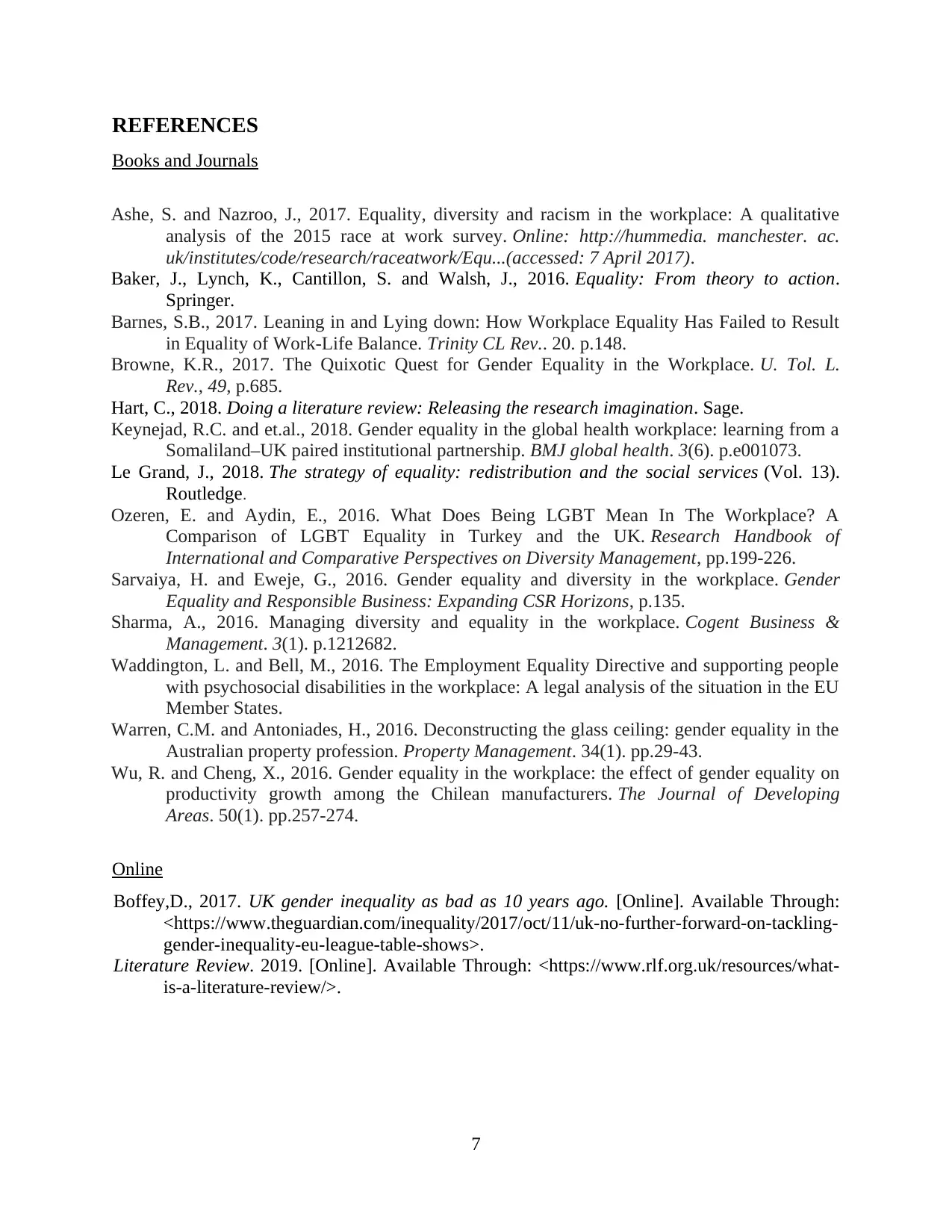
REFERENCES
Books and Journals
Ashe, S. and Nazroo, J., 2017. Equality, diversity and racism in the workplace: A qualitative
analysis of the 2015 race at work survey. Online: http://hummedia. manchester. ac.
uk/institutes/code/research/raceatwork/Equ...(accessed: 7 April 2017).
Baker, J., Lynch, K., Cantillon, S. and Walsh, J., 2016. Equality: From theory to action.
Springer.
Barnes, S.B., 2017. Leaning in and Lying down: How Workplace Equality Has Failed to Result
in Equality of Work-Life Balance. Trinity CL Rev.. 20. p.148.
Browne, K.R., 2017. The Quixotic Quest for Gender Equality in the Workplace. U. Tol. L.
Rev., 49, p.685.
Hart, C., 2018. Doing a literature review: Releasing the research imagination. Sage.
Keynejad, R.C. and et.al., 2018. Gender equality in the global health workplace: learning from a
Somaliland–UK paired institutional partnership. BMJ global health. 3(6). p.e001073.
Le Grand, J., 2018. The strategy of equality: redistribution and the social services (Vol. 13).
Routledge.
Ozeren, E. and Aydin, E., 2016. What Does Being LGBT Mean In The Workplace? A
Comparison of LGBT Equality in Turkey and the UK. Research Handbook of
International and Comparative Perspectives on Diversity Management, pp.199-226.
Sarvaiya, H. and Eweje, G., 2016. Gender equality and diversity in the workplace. Gender
Equality and Responsible Business: Expanding CSR Horizons, p.135.
Sharma, A., 2016. Managing diversity and equality in the workplace. Cogent Business &
Management. 3(1). p.1212682.
Waddington, L. and Bell, M., 2016. The Employment Equality Directive and supporting people
with psychosocial disabilities in the workplace: A legal analysis of the situation in the EU
Member States.
Warren, C.M. and Antoniades, H., 2016. Deconstructing the glass ceiling: gender equality in the
Australian property profession. Property Management. 34(1). pp.29-43.
Wu, R. and Cheng, X., 2016. Gender equality in the workplace: the effect of gender equality on
productivity growth among the Chilean manufacturers. The Journal of Developing
Areas. 50(1). pp.257-274.
Online
Boffey,D., 2017. UK gender inequality as bad as 10 years ago. [Online]. Available Through:
<https://www.theguardian.com/inequality/2017/oct/11/uk-no-further-forward-on-tackling-
gender-inequality-eu-league-table-shows>.
Literature Review. 2019. [Online]. Available Through: <https://www.rlf.org.uk/resources/what-
is-a-literature-review/>.
7
Books and Journals
Ashe, S. and Nazroo, J., 2017. Equality, diversity and racism in the workplace: A qualitative
analysis of the 2015 race at work survey. Online: http://hummedia. manchester. ac.
uk/institutes/code/research/raceatwork/Equ...(accessed: 7 April 2017).
Baker, J., Lynch, K., Cantillon, S. and Walsh, J., 2016. Equality: From theory to action.
Springer.
Barnes, S.B., 2017. Leaning in and Lying down: How Workplace Equality Has Failed to Result
in Equality of Work-Life Balance. Trinity CL Rev.. 20. p.148.
Browne, K.R., 2017. The Quixotic Quest for Gender Equality in the Workplace. U. Tol. L.
Rev., 49, p.685.
Hart, C., 2018. Doing a literature review: Releasing the research imagination. Sage.
Keynejad, R.C. and et.al., 2018. Gender equality in the global health workplace: learning from a
Somaliland–UK paired institutional partnership. BMJ global health. 3(6). p.e001073.
Le Grand, J., 2018. The strategy of equality: redistribution and the social services (Vol. 13).
Routledge.
Ozeren, E. and Aydin, E., 2016. What Does Being LGBT Mean In The Workplace? A
Comparison of LGBT Equality in Turkey and the UK. Research Handbook of
International and Comparative Perspectives on Diversity Management, pp.199-226.
Sarvaiya, H. and Eweje, G., 2016. Gender equality and diversity in the workplace. Gender
Equality and Responsible Business: Expanding CSR Horizons, p.135.
Sharma, A., 2016. Managing diversity and equality in the workplace. Cogent Business &
Management. 3(1). p.1212682.
Waddington, L. and Bell, M., 2016. The Employment Equality Directive and supporting people
with psychosocial disabilities in the workplace: A legal analysis of the situation in the EU
Member States.
Warren, C.M. and Antoniades, H., 2016. Deconstructing the glass ceiling: gender equality in the
Australian property profession. Property Management. 34(1). pp.29-43.
Wu, R. and Cheng, X., 2016. Gender equality in the workplace: the effect of gender equality on
productivity growth among the Chilean manufacturers. The Journal of Developing
Areas. 50(1). pp.257-274.
Online
Boffey,D., 2017. UK gender inequality as bad as 10 years ago. [Online]. Available Through:
<https://www.theguardian.com/inequality/2017/oct/11/uk-no-further-forward-on-tackling-
gender-inequality-eu-league-table-shows>.
Literature Review. 2019. [Online]. Available Through: <https://www.rlf.org.uk/resources/what-
is-a-literature-review/>.
7
⊘ This is a preview!⊘
Do you want full access?
Subscribe today to unlock all pages.

Trusted by 1+ million students worldwide
1 out of 9
Related Documents
Your All-in-One AI-Powered Toolkit for Academic Success.
+13062052269
info@desklib.com
Available 24*7 on WhatsApp / Email
![[object Object]](/_next/static/media/star-bottom.7253800d.svg)
Unlock your academic potential
Copyright © 2020–2025 A2Z Services. All Rights Reserved. Developed and managed by ZUCOL.





